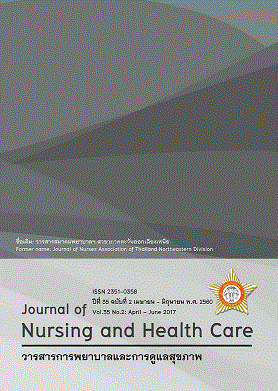การดำเนินชีวิตหลังการผ่าตัดต้อกระจกของผู้สูงอายุ ตำบลคูคต อำเภอลำลูกกา จังหวัดปทุมธานี :กรณีศึกษาเชิงคุณภาพ เฉพาะผู้ที่ได้รับการผ่าตัดจากโรงพยาบาลบ้านแพร้ว Daily activities of elderly after having cataract surgery, living in Kukot subdistrict, Lamlukka
คำสำคัญ:
การดำเนินชีวิต ต้อกระจก ผู้สูงอายุ การวิจัยเชิงคุณภาพ The screening and cataract surgery project should be operated every yearบทคัดย่อ
บทคัดย่อ
วัตถุประสงค์: เพื่อศึกษาชีวิตความเป็นอยู่หลังการผ่าตัดต้อกระจกของผู้สูงอายุ และประเมินโครงการคัดกรองต้อกระจกของผู้สูงอายุ
วัสดุและวิธีการ: การวิจัยครั้งนี้เป็นการวิจัยเชิงคุณภาพ ในผู้สูงอายุที่ผ่านการคัดกรองสุขภาพตาในโครงการคัดกรองต้อกระจก และไปรับการผ่าตัดต้อกระจกที่โรงพยาบาลบ้านแพ้ว (มหาชน) จำนวน 33 คน ซึ่งเป็นโครงการที่จัดร่วมกันระหว่างศูนย์แพทย์ปฐมภูมิและแพทย์แผนไทยประยุกต์ คณะแพทยศาสตร์ มหาวิทยาลัยธรรมศาสตร์ กับ เทศบาลเมืองลำสามแก้ว ตำบลคูคต อำเภอลำลูกกา จังหวัดปทุมธานี เก็บรวบรวมข้อมูลโดยผู้วิจัย สัมภาษณ์เชิงลึกตามแนวคำถาม วิเคราะห์ข้อมูลเชิงเนื้อหา
ผลการวิจัย: สัมภาษณ์เชิงลึกได้ 22 คน (ร้อยละ 66.7) เป็นเพศหญิง 17 คน อายุเฉลี่ย 72.14 ปี หลังจากทราบว่าเป็นต้อกระจกต้องรับการผ่าตัด ส่วนใหญ่ไม่กลัวเพราะอยากมองเห็น เคยผ่าตัดมาแล้ว มีเพื่อนไปผ่าด้วย มีคนบอกว่าไม่เจ็บ และชื่อเสียงของโรงพยาบาลบ้านแพ้ว ส่วนใหญ่มีความรู้สึกดีต่อการผ่าตัดต้อกระจกที่โรงพยาบาลบ้านแพ้ว เพราะได้รับบริการดี ใช้เวลาผ่าตัดไม่นาน ผ่าแล้วมองเห็นได้ดี มีอาหารให้ นอนค้างคืนเดียว มีเพื่อนไปด้วย และมีรถรับส่ง ส่วนใหญ่ตอบว่าไม่มีปัญหาที่ต้องนอนพักที่โรงพยาบาลบ้านแพ้ว ไม่เสียค่าใช้จ่ายในการผ่าตัดต้อกระจก มีความสุขดีหลังการผ่าตัดต้อกระจก ทำให้สามารถมองเห็น ดำเนินชีวิตได้เหมือนปกติสุข เกือบทุกคนเห็นว่าไม่มีความทุกข์หลังการผ่าตัดต้อกระจก มีชีวิตความเป็นอยู่ คุณภาพชีวิตหลังการผ่าตัดต้อกระจกดีขึ้น สามารถใช้ชีวิตประจำวันได้ปกติสุข ไม่เป็นภาระให้ผู้อื่น หากจะต้องผ่าตัดต้อกระจกอีกข้าง ส่วนใหญ่อยากเข้าร่วมโครงการเพราะไม่เสียค่าใช้จ่าย ได้รับบริการดี ชื่อเสียงที่ดีของโรงพยาบาล ทีมแพทย์พยาบาลเก่ง มีเพื่อนไปด้วย และสะดวกมีรถรับส่ง
Abstract
Objectives: To study lives and well-being after cataract surgery of the elderly and evaluate a cataract-screening project for the elderly.
Materials and Methods: This qualitative research was conducted with 33 elderly who had diagnosed with cataract by a cataract-screening project and underwent cataract surgery at Ban Phaeo Hospital. This project was conducted in collaboration with a Primary Medical Unit, the Applied Thai Traditional Medicine Centre, Faculty of Medicine, Thammasat University, Lam Samkaew Municipality, Kukot Subdistrict, and Lamlukka District of Pathumthani. Data were collected by the researchers using a guided questionnaire through in-depth interviews. Data analysis were done using content analysis.
Results: In-depth interviews were conducted on only 22 patients (66.7 percent); 17 of which were female. The average age of participants was 72.14 years old. Patients expressed that once aware of their cataract that needed surgery, most patients did not fear because they wanted to see well, had experienced previous surgery, had friends who also went for surgery at the same time, were told that it would not hurt, and the Hospital's reputation. In terms of satisfaction against cataract surgery at Ban Phaeo hospital, the majority of participants responded that they received good services; the surgery did not take time; they could see well after the surgery; food and transportation were provided free of charge; they only had to stay overnight, and they had somebody accompanying them. The majority of respondents stated that they had no problems to be hospitalized at Ban Phaeo Hospital. Moreover, they said that were happy because they had comfortable overnight stays and received health services free of charge. Their better eyesight from the surgery provided them with an ability to live their usual life independently resulting in their quality of life improvement. In case that cataract surgery is needed on another eye, the majority participants mentioned that they wanted to have the operation. Key success factors of the project enrolment included good and free services, the Hospital’s good reputation, competency of doctors, and nurses, peer hospitalization, and convenient transportation.



